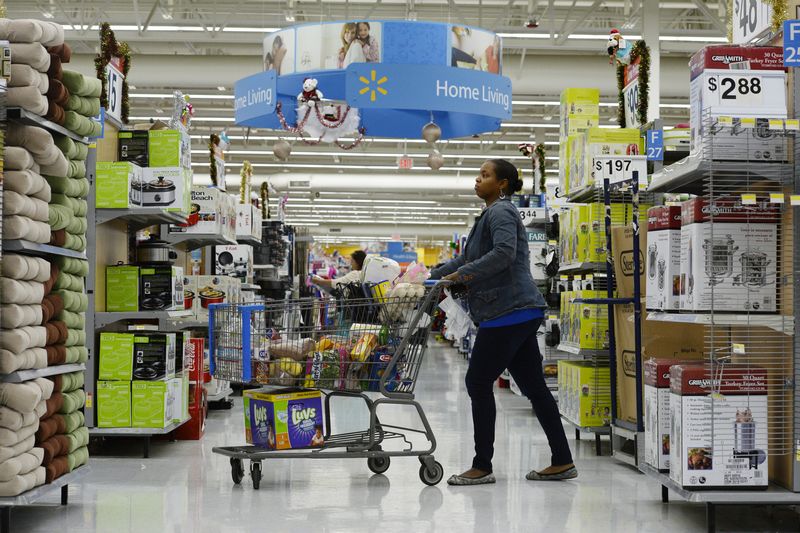By Lucia Mutikani
WASHINGTON (Reuters) - U.S. consumer spending fizzled in May as households cut back on purchases of new light trucks and other long-lasting manufactured goods amid higher borrowing costs, suggesting the economy lost some speed in the second quarter.
While the Commerce Department's report on Friday showed annual inflation rising last month at its slowest pace in more than two years, underlying price pressures remained too strong to discourage the Federal Reserve from returning to its strategy of raising interest rates in July, economists said. Inflation is by far still outpacing the U.S. central bank's 2% target.
The soft consumer spending took some shine off a raft of upbeat data on the labor and housing markets this month, which had painted a picture of a resilient economy.
"The recent stalling of consumer spending and somewhat better inflation news validate the Fed's decision to skip a meeting this month, though continued stickiness in core prices likely warrant another tap on the brakes in July," said Sal Guatieri, a senior economist at BMO Capital Markets in Toronto.
Consumer spending edged up 0.1% last month. Data for April was revised lower to show spending accelerating 0.6% instead of 0.8% as previously reported. Economists polled by Reuters had forecast consumer spending, which accounts for more than two-thirds of U.S. economic activity, rising 0.2%.
Spending on goods, which are typically bought on credit dropped 0.5%, with motor vehicle outlays plunging 23.3%. Spending on gasoline and other energy goods tumbled 23.4%. Goods spending increased 0.9 in April.
Outlays on services rose 0.4%, lifted by healthcare, transportation, housing and utilities, as well as financial services and insurance. Services outlays gained 0.5% in April.
When adjusted for inflation, consumer spending was unchanged. Data for April was revised lower to show the so-called real consumer spending rising only 0.2% instead of 0.5% as previously reported.
The stagnation in real consumer spending last month and the downward revision to April's data implied that consumer spending growth slowed to around a 1.0% annualized rate in the second quarter, economists estimated, after rising at a 4.2% rate in the January-March period, the fastest in nearly two years.
Robust consumer spending accounted for the economy's 2.0% growth pace last quarter, defying fears of a recession because of the Fed's hefty rate hikes.
Nevertheless, the economy likely continued to chug along
this quarter, with job gains, housing starts, orders for durable goods all strong and the goods trade deficit narrowing in May.
Growth estimates for the second quarter range from as low as a 0.5% rate to as high as a 2.3% pace.
Stocks on Wall Street were trading higher. The dollar fell against a basket of currencies. U.S. Treasury prices rose.
INCOMES, SAVING RATE RISE
Consumer spending remains underpinned by strong wage gains in a tight labor market. Personal income rose 0.4% last month, with wages increasing 0.5%.
Slowing inflation is raising consumers' purchasing power, with real disposable income rebounding 0.3%. The saving rate climbed to 4.6% from 4.3% in April, which could provide some cushion in the event of a recession.
But the outlook is less favorable. Most lower-income households are believed to have depleted savings accumulated during the COVID-19 pandemic.
The Supreme Court on Friday blocked President Joe Biden's plan to cancel $430 billion in student loan debt, which had been intended to benefit up to 43 million Americans.
"We've seen evidence that middle to lower income consumers are cutting back on discretionary spending," said Mike Graziano, consumer products senior analyst at RSM US in New York.
"Given the student loan relief plan was aimed at this customer cohort, any additional fixed monthly costs will result in additional financial pressure."
Separately, 26.6 million Americans with federal student loans will start making interest payments in October when a more than three-year moratorium ends. Morgan Stanley (NYSE:MS) estimates that the hit to households' disposable income could lower inflation-adjusted consumer spending by about 10 basis points this year and slice 7 basis points off GDP growth.
With consumer spending softening, inflation subsided. The personal consumption expenditures (PCE) price index gained 0.1% in May after rising 0.4% in April.
In the 12 months through May, the PCE price index advanced 3.8%. That was the smallest year-on-year increase since April 2021 and followed a 4.3% rise in April.
But underlying price pressures remain sticky. Excluding the volatile food and energy components, the PCE price index climbed 0.3% after rising 0.4% in the prior month.

The so-called core PCE price index increased 4.6% on a year-on-year basis in May after advancing 4.7% in April. The Fed tracks the PCE price indexes for monetary policy. Policymakers are closely watching core services excluding housing, which economists estimated increased 0.2% after rising 0.4% in April.
"We forecast at least one more rate hike, and leave the door open for more, given the stubbornness of inflation, and continued supports for consumer spending, including a robust labor market and rising real incomes," said Dana Peterson, chief economist at The Conference Board in Washington.
